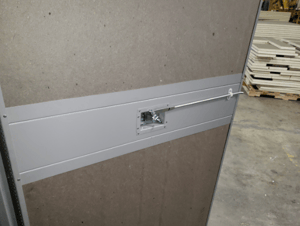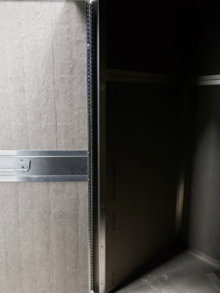Unobstructed access is critical to every pump cover because of the importance of providing a clear path to your pumps and their accompanying accessories and equipment. That’s why access panels on your pump enclosure are crucial. But there are two types of panels you can pick from, so how do you know which one is right for your project?
In a previous blog, I talked about the best place for an access panel on a pump cover. I explained that access panels should be situated in front of the control panels on your booster pumps because this makes it easier to maintain and test.
I also mentioned that some newer designs also come with hinges and have removable roofs to make it easy to get to your pump. Older designs are far less efficient. In fact, if something goes wrong you may need a crane.
Today I’d like to help you decide which type of access panel is right for your pump cover project: a completely removable access panel or a hinged access panel? Let’s take a look at both.
Removable Pump Cover Access Panels
Removable access panels can be a wonderful thing when covering most types of equipment, especially pumps. Just like the name says, they are completely removable and can be set aside and out of the way when performing maintenance or replacing equipment.
Our standard removable access panels have foldable and pad-lockable handles to deter theft. And depending on the size of the enclosure, you can even have multiple access panels in order to get at your equipment from any direction.
size of the enclosure, you can even have multiple access panels in order to get at your equipment from any direction.
Removable panels are also insulated to maintain heat inside the pump cover during the colder months. Most of Safe-T-Cover’s standard removable access panels are 38 ¼” wide and can be as tall as 90”.
Hinged Access Panels For Pump Covers
The hinged access panel is manufactured similarly to our standard removable access panel. Hinged panels come with foldable and pad-lockable handles and are also insulated to maintain heat inside the enclosure.
Just like the removable access panels, you can have multiple hinged panels throughout the enclosure. You can even install them higher on the enclosure in case you need to reach hatches on top of filtration tanks or to add or remove material from the outside of the enclosure.
As with the removable access panels, you’ll want to consider the size of your hinged access panels to avoid ending up with something that becomes cumbersome to handle and isn’t necessary to accomplish the task at hand.
The biggest difference between hinged panels and removable panels is that hinged panels open like a conventional door.
When Are Hinged Access Panels More Appropriate?
So what might be a situation when we wouldn’t recommend using a completely removable access panel?
One situation might be if the application is calling out very tall access panels. We typically recommend our access panels not exceed 84” high. Anything over 84” can be tougher to manage and usually aren’t necessary to allow an average-sized person to walk into the pump enclosure. 
Another example of when a hinged access panel is more appropriate is for a pump cover on the roof of a tall building. Wind can become a problem when dealing with enclosures on top of tall buildings, and we wouldn’t want an access panel that was removed (and then set aside while work was being done) to get picked up by a gust of wind and damage neighboring property. Or worse yet, hit someone and hurt them. So in this case, we’d recommend a hinged access panel.
Hinged access panels are a good solution for enclosures that are on top of tall buildings or where high winds can be a factor. They’re securely attached to the enclosure itself, you don’t have to worry about them flying off and causing any damage.
The Importance of Pump Covers And Access Panels
A pump cover (or pump enclosure) provides complete protection for your equipment. From the weather to vandals, you’ll never have to worry about your pump if it is in an enclosure. A pump cover can even help to keep the noise down and your neighbors happy.
But it’s the access panels that provide a safe and easy pathway to your pump when you need it. This is extremely important, not only in the event of an emergency but because your pump will most likely have to be tested annually (like an emergency pump for a sprinkler system). An annual test is one of the best ways to ensure that your pump is working properly.
If you’d like to learn more about access panels for pump enclosures, download our pump cover checklist. You can use it to determine the dimensions of your pump enclosure.
In many cases, custom pump enclosures turn out to be less expensive than our standard models because a standard enclosure may contain too much space. If your enclosure is larger than it needs to be, you’re wasting money by paying for something you don’t need.
Or you can reach out to me directly. My email is chris@safe-t-cover.com. We are happy to help you design the best pump cover for your project.




